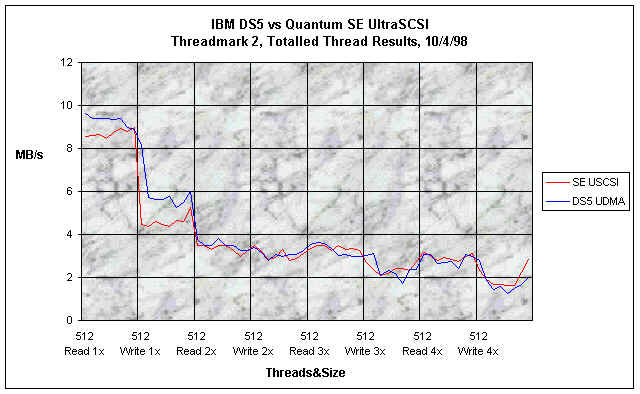
Ultra SCSI vs UDMA
There is and always has been a lot of debate regarding the performance difference that you will see between the SCSI and EIDE interfaces. No history here as I am simply trying to compare the latest and greatest versions of both interfaces, with the latest drivers and modern, similarly spec'd hard drives.
A lot of the debate you will see consists of; My 10000 rpm Ultra SCSI hard drive is way faster than YOUR UDMA hard drive. This fact is of course true. What I am trying to show here is "does a realistic performance difference exist between similarly spec'd hard drives when compared on the two interfaces". I am quite interested in the answer to this question as I need to upgrade my DS5 soon, and I have no idea if the extra money spent on SCSI will provide a useful performance boost.
My first round of tests consist of an IBM Deskstar5 vs a Quantum SE Ultra SCSI. Both drives have a capacity of 6.4GB. Both drives are currently shipping and are "mainstream" drives.
Test Specs
| H/W config | AsusT2P4, P133, 40MB, Asus SC875 UltraSCSI controller, Quantum 6.4GB SE UltraSCSI H/D, Onboard Busmastering EIDE Controller, IBM Deskstar 5 UDMA H/D, WD 840MB IDE |
| S/W config | NT4, SP3, MS Ide hotfix applied; DMA Check Enabled
Both Channels. Read and Write Caches Both ON for SCSI drive. NT Booted from WD IDE Drive. |
| H/D config | WD Secondary Master (NT System and Boot drive) Deskstar 5 UDMA Primary Channel Master, Single Device Quantum SE single device on SCSI controller. Ultra ON. Both Test Drives Formatted with a single 6.4GB NTFS parition, 4K clusters. |
Threadmark |
Version 2 used. |
Overall Results
| Drive | SE UltraSCSI | DS5 UDMA |
| Overall | 5.54 MB/s | 5.93 MB/s |
| Total CPU | 29.16% | 35.63% |
| Aver CPU/MB | 5.26%/MB transfered | 6.01%/MB transfered |
Graph of Totalled Thread Results

By using the totalled threaded results I am hoping to show if there is any performance improvement through the use of the SCSI interface vs the EIDE interface. Unfortunately there are so many factors involved in the above results (drive mechanics, h/d caching, interface, s/w drivers, s/w caching); even variations in physical drive performance are shadowing the interface effects.
Anyway you are welcome to draw your own conclusions. If you look at the above chart as you travel along the x axis you are seeing the totalled thread results for single thread reading (at 512, 1, 2, 4, 8, 16, 32, 64K) then single thread writing (at 512, 1, 2, 4, 8, 16, 32, 64K), then two thread reading (at 512, 1, 2, 4, 8, 16, 32, 64K) and so on. It is interesting to note that the DS5 has a defined higher single thread speed, considering that is has a far lower data density per platter (1.6GB vs 2.15GB). Perhaps because it uses no ID sector formatting giving an actual *real* usable data rate higher than the SE?
Results
You are welcome to download my results in this file ... se64ds64.zip. Results #1 and #2 are for the SE, #3 and #4 are the DS5.
Conclusion
Perhaps the only thing I have shown is that these two drives are of relatively equal performace. I posted something about these results to the comp.sys.ibm.pc.hardware.storage newsgroup along with some comments regarding the cost effectiveness of the two solutions.
This upset a couple of people, blaiming me for testing the cheapest and slowest SCSI drive around. This could not be further from the truth. I have compared two similarly spec'd hard drives, that will be *high* volume, every day John Doe gets to use and own one drives. Not esoteric drives that are designed specifically for servers.
If you are interested the normalised difference in price for the DS5 vs SE+Ultra SCSI controller is 1 : 1.7. ie if you want a SCSI solution on a modern pentium m/b or above you will pay an extra 70% for the privilage. I myself would much rather buy a backup drive or 3d card :)